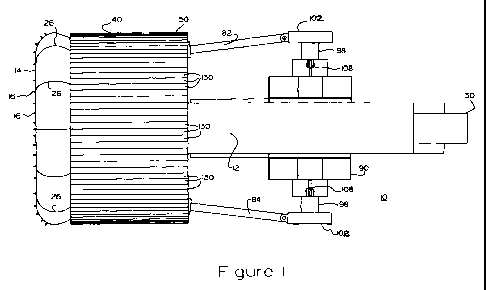Une partie des informations de ce site Web a été fournie par des sources externes. Le gouvernement du Canada n'assume aucune responsabilité concernant la précision, l'actualité ou la fiabilité des informations fournies par les sources externes. Les utilisateurs qui désirent employer cette information devraient consulter directement la source des informations. Le contenu fourni par les sources externes n'est pas assujetti aux exigences sur les langues officielles, la protection des renseignements personnels et l'accessibilité.
L'apparition de différences dans le texte et l'image des Revendications et de l'Abrégé dépend du moment auquel le document est publié. Les textes des Revendications et de l'Abrégé sont affichés :
| (12) Demande de brevet: | (11) CA 2774492 |
|---|---|
| (54) Titre français: | MODIFICATION APPORTEE A UNE STRUCTURE DE TUNNELIER POUR REALISER UNE INSTALLATION DE SUPPORT DE TOIT |
| (54) Titre anglais: | MODIFICATION TO A TBM STRUCTURE TO PROVIDE ROOF SUPPORT INSTALLATION |
| Statut: | Réputée abandonnée et au-delà du délai pour le rétablissement - en attente de la réponse à l’avis de communication rejetée |
| (51) Classification internationale des brevets (CIB): |
|
|---|---|
| (72) Inventeurs : |
|
| (73) Titulaires : |
|
| (71) Demandeurs : |
|
| (74) Agent: | EDWARD H. OLDHAMOLDHAM, EDWARD H. |
| (74) Co-agent: | |
| (45) Délivré: | |
| (86) Date de dépôt PCT: | 2009-01-30 |
| (87) Mise à la disponibilité du public: | 2010-01-14 |
| Licence disponible: | S.O. |
| Cédé au domaine public: | S.O. |
| (25) Langue des documents déposés: | Anglais |
| Traité de coopération en matière de brevets (PCT): | Oui |
|---|---|
| (86) Numéro de la demande PCT: | PCT/CA2009/000107 |
| (87) Numéro de publication internationale PCT: | WO 2010003213 |
| (85) Entrée nationale: | 2012-04-23 |
| (30) Données de priorité de la demande: | ||||||
|---|---|---|---|---|---|---|
|
L'invention porte sur un tunnelier comportant un élément de forme cylindrique situé sur ledit tunnelier juste derrière la tête de forage rotative, ledit élément ayant un diamètre similaire à celui dudit tunnel, et comprenant des composants en section afin d'avoir un diamètre réglable, ledit élément comportant une pluralité d'éléments de cornières en acier soudés à la surface du composant supérieur de façon à s'étendre axialement le long de la longueur dudit élément de forme cylindrique, lesdits éléments de cornières en acier formant des réceptacles s'étendant axialement à l'intérieur de ceux-ci.
A TBM having a cylindrically shaped member located on said TBM just behind the rotating boring head, said member being of similar diameter as said tunnel and comprising sectionalized components so as to be adjustable in diameter, said member having a plurality of steel angle members welded to the surface of the top-most component so as to extend axially along the length of said cylindrically shaped member, said steel angle members forming axially extending receptacles therein.
Note : Les revendications sont présentées dans la langue officielle dans laquelle elles ont été soumises.
Note : Les descriptions sont présentées dans la langue officielle dans laquelle elles ont été soumises.

2024-08-01 : Dans le cadre de la transition vers les Brevets de nouvelle génération (BNG), la base de données sur les brevets canadiens (BDBC) contient désormais un Historique d'événement plus détaillé, qui reproduit le Journal des événements de notre nouvelle solution interne.
Veuillez noter que les événements débutant par « Inactive : » se réfèrent à des événements qui ne sont plus utilisés dans notre nouvelle solution interne.
Pour une meilleure compréhension de l'état de la demande ou brevet qui figure sur cette page, la rubrique Mise en garde , et les descriptions de Brevet , Historique d'événement , Taxes périodiques et Historique des paiements devraient être consultées.
| Description | Date |
|---|---|
| Demande non rétablie avant l'échéance | 2015-01-30 |
| Le délai pour l'annulation est expiré | 2015-01-30 |
| Inactive : Abandon.-RE+surtaxe impayées-Corr envoyée | 2014-01-30 |
| Réputée abandonnée - omission de répondre à un avis sur les taxes pour le maintien en état | 2014-01-30 |
| Inactive : Page couverture publiée | 2012-06-06 |
| Exigences relatives à une correction du demandeur - jugée conforme | 2012-05-03 |
| Inactive : Inventeur supprimé | 2012-05-03 |
| Inactive : Notice - Entrée phase nat. - Pas de RE | 2012-05-03 |
| Exigences relatives à une correction du demandeur - jugée conforme | 2012-05-02 |
| Demande reçue - PCT | 2012-05-02 |
| Inactive : CIB en 1re position | 2012-05-02 |
| Inactive : CIB attribuée | 2012-05-02 |
| Inactive : CIB attribuée | 2012-05-02 |
| Inactive : CIB attribuée | 2012-05-02 |
| Exigences pour l'entrée dans la phase nationale - jugée conforme | 2012-04-23 |
| Demande publiée (accessible au public) | 2010-01-14 |
| Date d'abandonnement | Raison | Date de rétablissement |
|---|---|---|
| 2014-01-30 |
Le dernier paiement a été reçu le 2012-04-23
Avis : Si le paiement en totalité n'a pas été reçu au plus tard à la date indiquée, une taxe supplémentaire peut être imposée, soit une des taxes suivantes :
Veuillez vous référer à la page web des taxes sur les brevets de l'OPIC pour voir tous les montants actuels des taxes.
| Type de taxes | Anniversaire | Échéance | Date payée |
|---|---|---|---|
| Taxe nationale de base - générale | 2011-12-23 | ||
| Rétablissement (phase nationale) | 2011-12-30 | ||
| TM (demande, 2e anniv.) - générale | 02 | 2011-01-31 | 2012-03-08 |
| TM (demande, 4e anniv.) - générale | 04 | 2013-01-30 | 2012-04-23 |
| TM (demande, 3e anniv.) - générale | 03 | 2012-01-30 | 2012-04-23 |
Les titulaires actuels et antérieures au dossier sont affichés en ordre alphabétique.
| Titulaires actuels au dossier |
|---|
| MICHAEL P. MCNALLY |
| Titulaires antérieures au dossier |
|---|
| S.O. |